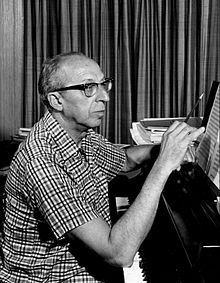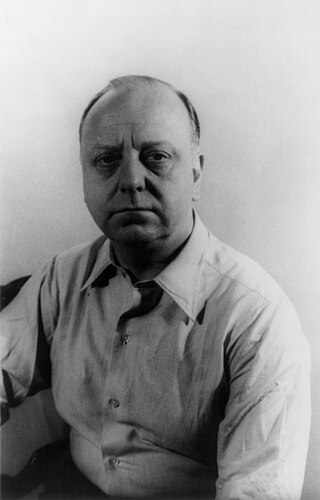
Virgil Thomson was an American composer and critic. He was instrumental in the development of the "American Sound" in classical music. He has been described as a modernist, a neoromantic, a neoclassicist, and a composer of "an Olympian blend of humanity and detachment" whose "expressive voice was always carefully muted" until his late opera Lord Byron which, in contrast to all his previous work, exhibited an emotional content that rises to "moments of real passion".
Concerto in F is a composition by George Gershwin for solo piano and orchestra which is closer in form to a traditional concerto than his earlier jazz-influenced Rhapsody in Blue. It was written in 1925 on a commission from the conductor and director Walter Damrosch. It is just over half an hour long.

Magnus Gustaf Adolf Lindberg is a Finnish composer and pianist. He was the New York Philharmonic's composer-in-residence from 2009 to 2012 and has been the London Philharmonic Orchestra's composer-in-residence since the beginning of the 2014–15 season.

Alexander Tansman was a Polish composer, pianist and conductor who became a naturalized French citizen in 1938. One of the earliest representatives of neoclassicism, associated with École de Paris, Tansman was a globally recognized and celebrated composer.
David Walter Del Tredici was an American composer. He won a Pulitzer Prize for Music and was a Guggenheim and Woodrow Wilson fellow. Del Tredici is considered a pioneer of the Neo-Romantic movement. He was also described by the Los Angeles Times as "one of our most flamboyant outsider composers".
Unsuk Chin is a South Korean composer of contemporary classical music, who is based in Berlin, Germany. Chin was a self-taught pianist from a young age and studied composition at Seoul National University as well as with György Ligeti at the Hochschule für Musik und Theater Hamburg.
The Piano Concerto No. 3 in E major, Sz. 119, BB 127 of Béla Bartók is a musical composition for piano and orchestra. The work was composed in 1945 during the final months of his life, as a surprise birthday present for his second wife Ditta Pásztory-Bartók.
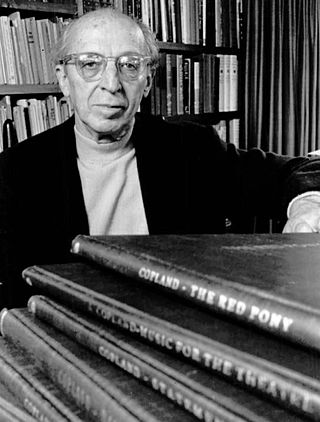
Connotations is a classical music composition for symphony orchestra written by American composer Aaron Copland. Commissioned by Leonard Bernstein in 1962 to commemorate the opening of Philharmonic Hall in New York City, United States, this piece marks a departure from Copland's populist period, which began with El Salón México in 1936 and includes the works he is most famous for such as Appalachian Spring, Lincoln Portrait and Rodeo. It represents a return to a more dissonant style of composition in which Copland wrote from the end of his studies with French pedagogue Nadia Boulanger and return from Europe in 1924 until the Great Depression. It was also Copland's first dodecaphonic work for orchestra, a style he had disparaged until he heard the music of French composer Pierre Boulez and adapted the method for himself in his Piano Quartet of 1950. While the composer had produced other orchestral works contemporary to Connotations, it was his first purely symphonic work since his Third Symphony, written in 1947.
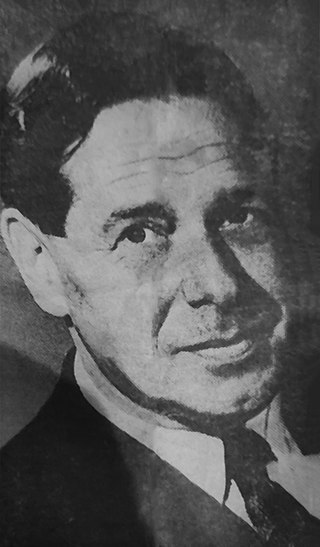
Arthur Leslie Benjamin was an Australian composer, pianist, conductor and teacher. He is best known as the composer of Jamaican Rumba (1938) and of the Storm Clouds Cantata, featured in both versions of the Alfred Hitchcock film The Man who Knew Too Much, in 1934 and 1956.
Aaron Copland's Clarinet Concerto was written between 1947 and 1949, although a first version was available in 1948. The concerto was later choreographed by Jerome Robbins for the ballet Pied Piper (1951).
Phillip Ramey is an American composer, pianist, and writer on music.

Four Anniversaries is a composition for piano written in 1948 by the American composer Leonard Bernstein.
Robert Moffat (variously "Moffatt" and "Moffett") Palmer was an American composer, pianist and educator. He composed more than 90 works, including two symphonies, Nabuchodonosor, a piano concerto, four string quartets, three piano sonatas and numerous works for chamber ensembles.

Andrey Rafailovich Kasparov is an Armenian-American pianist, composer, and professor, who holds both American and Russian citizenship.
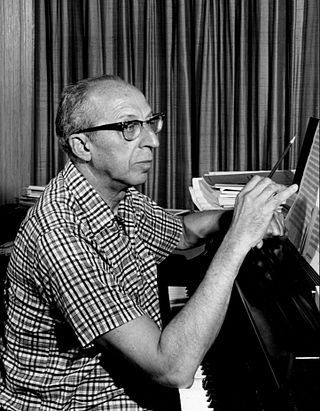
Danzón cubano is a composition for two pianos by American composer Aaron Copland. The piece, written in 1942, was inspired by the Cuban genre of the same name. It was first arranged for orchestra in 1946.
The Concerto for Piano and Orchestra is a musical composition by the American composer Aaron Copland. The work was commissioned by the conductor Serge Koussevitzky who was then music director of the Boston Symphony Orchestra. It was first performed on January 28, 1927, by the Boston Symphony Orchestra conducted by Koussevitzky with the composer himself as the soloist. The piece is dedicated to Copland's patron Alma Morgenthau Wertheim.

Seven Anniversaries is a collection of short piano pieces by American composer Leonard Bernstein, written between 1942 and 1943. It is the first installment in a series of Anniversaries, followed by Four Anniversaries (1948), Five Anniversaries (1949–51), and Thirteen Anniversaries (1988).
The Short Symphony, or Symphony No. 2, is a symphony written by the American composer Aaron Copland from 1931 to 1933. The name derives from the symphony's short length of only 15 minutes. The work is dedicated to Copland's friend, the Mexican composer and conductor Carlos Chávez. The symphony's first movement is in sonata-allegro form, and its slow second movement follows an adapted ternary form. The third movement resembles the sonata-allegro but has indications of cyclic form. The composition contains complex rhythms and polyharmonies, and it incorporates the composer's emerging interest in serialism as well as influences from Mexican music and German cinema. The symphony includes scoring for a heckelphone and a piano while omitting trombones and a percussion section. Copland later arranged the symphony as a sextet.
Four Sabras is a short composition for solo piano by American composer Leonard Bernstein. Each Sabra refers to vignettes or portraits of different fictitious Israeli children.
